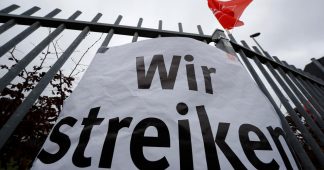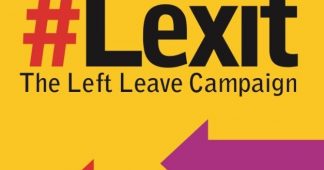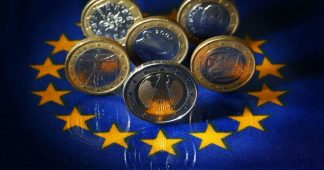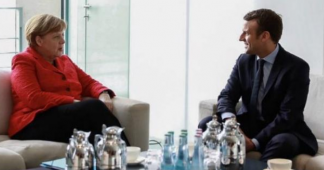Another social-democratic party with a death wish. In the Italian elections in March the question is not if, but how poorly the social-democrats do. Like most social-democratic parties in Europe, they too are politically and morally bankrupt. What are the alternatives?
Sergio Cesaratto is Professor of Growth and Development Economics and of Monetary and Fiscal Policies in the European Monetary Union, University of Siena
Cross-posted from Makroskop
Translated from the Italian version by BRAVE NEW EUROPE
You ask left-wingers these days: “Are you abstaining or voting for someone?” Beyond the political candidates on offer, see below, there is a fundamental problem concerning Italian democracy and that of the other Euro-zone countries, with the exclusion of Germany (and its satellites). In democracy we vote fundamentally on two sets of issues: socio-economic choices and civil rights.
- I vote on the left-hand side of Phillips Curve
With regard to the first choice, economics students are told that once, in the Keynesian era, there was a menu of macroeconomic choices called the Phillips Curve: this curve (figure 1) reacted to the level of unemployment together with that of inflation. The idea was that at low unemployment levels, to the left of the curve [sic], the strengthening of the unions’ bargaining power would lead to an increase in real wages, but also in prices; on the other hand, to the right of the curve, low inflation resulted in a high number of unemployed. In the belle epoch of the past, the workers, represented by the left, favoured full employment and high wages, while the petit and middle-class bourgeoisie (preoccupied with their savings) favoured low inflation and social peace by voting centre-right.

Graph 1 – The Phillips Curve
In the small and fortunate social-democratic Nordic nations and in Germany it was possible to obtain the best of both worlds: full employment and low inflation. The trick was to base the growth in aggregate demand not on wage-driven domestic demand, but on exports. Wage moderation thus resulted in an increase in exports, employment, and productivity and thus, in the long run, also in real wages.
In the “Keynesian” nations, such as France and the United Kingdom (and in the United States), domestic demand (which included public expenditure) played a more important role, with consequent imbalances in external accounts (thus supporting the social-democratic neo-mercantilism of the first group of nations).
In the 1950s, Italy followed an export-led model similar to Germany’s (so much so that in 1959 the Financial Times referred to the lira as the most stable currency in the world). However, the Italian bourgeoisie were not as intelligent as the German bourgeoisie in permitting the great masses to participate in the fruits of the nation’s economic miracle, so that social advancements were obtained not through social consensus, but through conflict (or clientelistic redistribution of Christian Democrat brand). Italy thus slipped towards a disordered Keynesianism.
In the various countries there was the possibility of choosing between economic policies that were more oriented towards workers or the bourgeoisie. From the 1980s, however, universities began to teach young people that the Phillips’ curve had ceased to exist since the 1970s (if it ever existed), and that the economy, if allowed to operate freely, would lead to a “natural” equilibrium where there is full employment and price stability. In this context, fiscal policy had to be bound by a balanced budget, while monetary policy had to be assigned the sole task of price stability. Hence the idea of central banks’ independence from (democratic) power. However, there was always the danger that some central bank president, too sensitive to social issues, would continue to believe in the unemployed-inflation trade-off (the old Phillips Curve) and favour employment even at the expense of price instability. In the seventies a wise and democratic economist, Paolo Baffi, governed monetary policy in this sense: better a weak lira than high unemployment. However, the “sagacious” economists at the Bocconi University in Milan (Giavazzi and Pagano 1988) provided a new option: tying one’s hands with the single currency. Deprived of monetary sovereignty, it was no longer possible to preserve the Italian model of high inflation, defending employment and wages through external devaluation in order to maintain competitiveness. With the loss of monetary sovereignty, you lose your ability to vote on which point of the Phillips curve you place yourself, and democracy is crippled. European Monetary Union is the instrument with which capital has deprived national democracy of its most essential economic tool, i. e. the social and distributive conflict which, if well regulated (Hirschman 1994), is the heart of democracy.
There remains the question of voting on civil rights, which is certainly important, but which ends up being a weapon to hide the stripping from democracy of socio-economic issues. For example, Matteo Renzi’s Democratic Party has tried to present itself as (still) left-wing advocating the approval of laws concerning gay couples or the law on Patient Decree (the right to interrupt treatments that are too invasive) and, more timidly given the opposition of public opinion, of jus soli in favour of hundreds of thousands of children born in Italy, whose parents are immigrants, but who have attended Italian schools, and to all intents and purposes are Italians.

Comic by Plantu
- The beautiful economy
The first point to be made is that the Italian Left’s awareness concerning the economy is limited, if not completely non-existent. In fact, despite the intense work carried out in recent years by a group of heterodox economists[1], which has influenced public opinion, most Leftists – if not disillusioned and disinterested – have fallen completely into the trap of confusing Europeanism with internationalism.
The goal of these heterodox economists has been to convince the Left that the euro zone’s Economic & Monetary Union (EMU) cannot be reformed in a democratic and progressive direction. The German mercantilist model is incompatible with the current version of EMU (even according to conventional economic theory) (see Cesaratto 2017,2018). They have also tried to explain how Italian economic decline was determined precisely by the self-imposed foreign constraint of the single currency (and the European monetary system before it) (Bagnai 2016).
Of course, nobody denies that Italy leaving the euro would be a dramatic event. Nor does anyone believe that it would automatically resolve the country’s problems. My opinion is that if Italy leaves the euro zone, it will be after a financial crisis similar to that in 2012, assuming that this time the country would refuse European political and economic diktats.
The radical Left, however, has adopted an ostrich-like policy, believing in a progressive project consisting of the restoration of a series of legal guarantees on employment, and a list of vague environmental projects, refusing acknowledge the new gold standard of the euro as a trap.
We fear that, if things go to plan, the drafting of the programme will be entrusted to jurists and sociologists without involving any serious radical economists. In the worst case scenario, the project will consist of a list of demands emanating from the grassroots movement as if such requests could quite simply be (please forgive the oxymoron) the fountainhead of a political project.
- The policies on offer
The left-wing voter will certainly consider, among possible options, voting for the 5 Star Movement (M5S). Let us therefore begin with this option. The decision-making processes of this party/movement are opaque, to say the least. Selecting candidates appears to be a process of wrangling among a small number of members, of a ruling class, for political jobs, rather than a democratic and participatory exercise. This is precisely the opposite of the struggle against the political caste, which is what these people say is their political aim. Their economic programme is vague, oscillating between a referendum on leaving the euro and issuing a parallel currency (a proposal that would be opposed by other member states). My impression is that an M5S government would introduce austerity policies by justifying cuts in public spending as cuts in caste privileges. The M5S will hardly reach a parliamentary majority, especially after the very poor figure that the Five Star mayors have cut in the government of some cities, particularly in Rome. Many on the left (including me in the ballot for the Mayor of Rome) voted M5S, many will not do it again. The M5S will probably win the most seats in parliament, but with not more than 35% of the votes.
Claiming to be realistic or moderate, the left-wing voter might choose the Democratic Party (PD) as an option. Unfortunately it is difficult these days, rebus sic stantibus, to consider the PD as a left-wing party. Moreover, the prospect proffered by Renzi is for a grand coalition with Berlusconi, and Paolo Gentiloni (the current President of the Council) as its leader. The parliamentary arithmetic for this solution is uncertain.
To the left of the PD, an electoral alliance was recently formed called Liberi e Pari (Free and Equal) founded by a group of former communists who left the PD last autumn (including D’ Alema and Bersani) and by representatives of the Italian Left (many former members of the Sinistra Ecologia Libertà). As its electoral leader the group appointed Pietro Grasso, a former magistrate, who headed the Anti-Mafia Agency and was also earlier President of the Senate.
Free and Equal’s political programme à la Jeremy Corbyn (leader of Britain’s Labour Party) is in some respects well-structured. The party has a microeconomic policy, but it avoids tackling the European issue with realism. Fassina seems to have renounced an open battle on these issues did previously). The potential vote of Free and Equal is estimated to be around 7-8 percent – and after the elections it does not rule out an agreement with the M5S (which for now it officially disdains). Confronted with these decisions Free and Equal could split up following the elections.
Even further to the left is a new party called Power to the People, in which are merged, among others, Communist Refoundation (the part of the Communist Party that in 1991 did not want to join the PDS-DS-PD, which at its peak reached 8% of the votes, but has had no seats in parliament for years) and above all the Network of Communist-USB. The Communist Network is the political arm of the USB (Basic Union of Trade Unions), an autonomous union that has a good support among some sectors of workers. Grass-roots groups and social institutions complete the list. This makes Power to the People more attractive than Free and Equal, which very much resembles a means for a caste of prominent left-wingers try to regain a parliamentary seat. Power to the People has a “shopping list” programme from the grass-roots, i. e. a list of more or less interesting claims without an organic design (the party may be new, but the Italian Left has failed to develop a coherent political and social policy for decades).
Regarding Europe, Power to the People is more radical than Free and Equal, yet favours the progressive European approach of “we will change the treaties”. Power to the people will hardly exceed the threshold of 3% to enter Parliament. Many militants hope that, whatever the case, the experience will lead to a more consistent and genuine radical left-wing party.
This is the choice confronting left-wing voters, which is still a non-choice, because any programme that seriously aims at full employment and the restoration of labour and social rights implies a clash with Europe and requires very radical economic measures. There is little awareness of this. I often wonder whether, instead of calling for implausible break-ups with Europe, it would not be more serious to work on a reformist programme within the framework of the existing situation. As a genuine Keynesian I believe that, without the growth of aggregate demand, the Italian economy has no chance of recovery, and that no reforms can be effected (which are very different from the types of reforms supported by Europe) without the necessary funding
- Whom to vote for?
In conclusion, the left has inadequate economic programmes and it is no coincidence that neither of Free and Equal nor of Power to the People consulted left-wing economists while preparing their political policies. This is serious and is the result of an Italian cultural deficit in which a philosophical-legal culture prevails over a more analytical one. The European issues have thus been left to the right, particularly to the Lega Nord, which treats this topic as a demagogue would. Also on the issue of immigration, which has understandably caused a lot of disorientation among Italians, the Left have not managed to develop a balanced and convincing policy.
Last but not least, the traditional left-wing base is more fragmented and divided in Italy than across the Alps. The large corporations, which were central to the Italian political and social landscape in the 1960s, have disappeared, victims of an unregulated social conflict and the lack of technological foresight on the part of entrepreneurs. What has remained is largely in the hands of foreign investors. Thus the working class is fragmented and dispersed, while precarious employment conditions and the lack of workers’ rights determine the lives of young people in Italy, including those with qualifications.
Thus my personal sympathies go by default to Power to the People, in the hope that it will free itself from the elements of demagogy and extremist verbosity “from below” towards the constitution of a radically reformist left-wing political party that knows how to integrate the organisations and work of the grass-roots movements with a political-intellectual programme. I doubt it will happen, but let us pretend that it will. Of course, I sincerely hope that both Alberto Bagnai and Stefano Fassina will do so. In truth they are the only two candidates who are truly competent on the issues that matter. Then, with luck, things will improve.
Published at https://braveneweurope.com/sergio-cesaratto-who-should-i-vote-for-the-left-and-the-italian-elections











